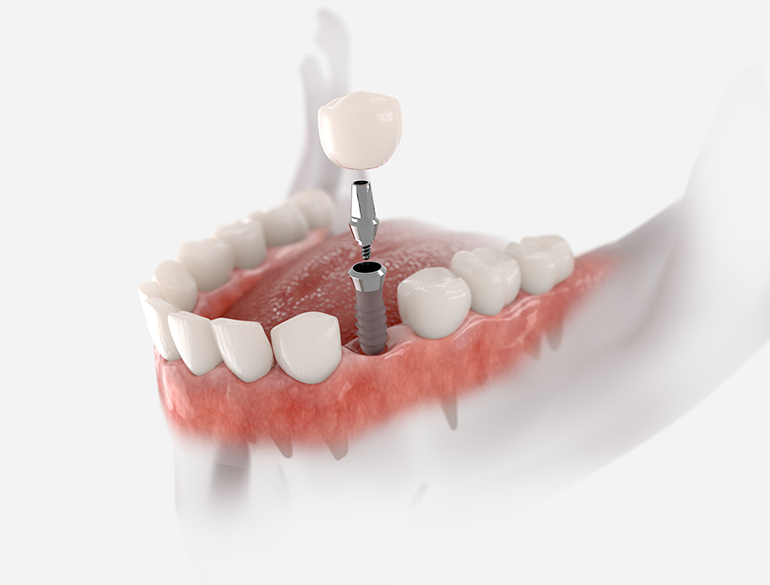7 Easy Facts About Dental Sense Explained
7 Easy Facts About Dental Sense Explained
Blog Article
Facts About Dental Sense Revealed
Table of ContentsFascination About Dental SenseAll about Dental SenseSome Ideas on Dental Sense You Need To KnowNot known Details About Dental Sense
are clinical gadgets operatively implanted right into the jaw to restore an individual's capacity to eat or their look. They provide assistance for man-made (phony) teeth, such as crowns, bridges, or dentures. When a tooth is lost due to injury or disease, a person can experience issues such as rapid bone loss, defective speech, or modifications to chewing patterns that result in discomfort.Oral dental implant systems contain a dental implant body and dental implant abutment and might also consist of a joint fixation screw. Professional teeth whitening. The dental implant body is operatively placed in the jawbone in location of the tooth's origin. The oral implant joint is typically attached to the dental implant body by the abutment addiction screw and extends through periodontals into the mouth to sustain the connected fabricated teeth
(https://www.goodreads.com/user/show/186244556-matthew-music)Structure of The Dental Implant System choosing oral implants, talk with your oral supplier regarding the prospective benefits and risks, and whether you are a prospect for the treatment. Things to consider: Your total health is a vital consider identifying whether you are an excellent candidate for dental implants, the length of time it will require to recover, and how long the dental implant may remain in area.
Cigarette smoking might affect the healing process and reduce the long-term success of the dental implant. The recovery process for the dental implant body might take a number of months or longer, during which time you commonly have a short-term joint instead of the tooth. the dental implant procedure: Carefully adhere to the dental hygiene directions given to you by your oral copyright.
What Does Dental Sense Mean?
Implant failure can lead to the need for another surgery to take care of or change the dental implant system. Brings back the capacity to chew Recovers aesthetic appearance Aids maintain the jawbone from diminishing due to bone loss Preserves the health of the surrounding bone and gums Aids keep adjacent (close-by) teeth stable Improves lifestyle Damage to bordering natural teeth throughout implant placement Injury to the surrounding cells during surgery, such as sinus opening Injury throughout surgical treatment (as an example, fracture of surrounding jawbone) Insufficient feature, such as seeming like the teeth do not attack with each other typically A feeling that the tooth is loosened or turning in place arising from a joint screw loosening Implant body failure (looseness of the implant body) as a result of systemic infection, which may be much more most likely in people with unchecked diabetes mellitus due to neighborhood infection in bone and gum tissues supporting the dental implant body because of postponed healing, which might be much more likely in clients that smoke Difficulty cleaning the gums around the dental implant, leading to poor dental hygiene Neglected gum condition Post-surgical feeling numb as a result of nerve impingement or damage Constantly notify healthcare suppliers and imaging technicians that you have oral implants before any magnetic resonance imaging (MRI) or x-ray treatments.
FDA is not knowledgeable about any negative events reported for MRI or x-ray treatments with oral implants. Dental implants systems are generally made of materials that adhere to worldwide consensus standards of the International Company for Standardization (ISO) or ASTM International. These requirements have details of what makes a secure material.

A dental implant is a framework that replaces a missing tooth. With screw-like gadgets, the cosmetic surgeon inserts a dental implant into the jawbone, and it works as a support for a fabricated tooth, called a crown. A tool called a joint attaches the man-made tooth to the oral implant. The crown is customized to fit the individual's mouth and match the color of their teeth.
The Single Strategy To Use For Dental Sense
Some people are not qualified for oral implant surgery. It is for dental surgeons to operate on people with: acute illnessuncontrollable metabolic diseasebone or soft cells illness or infectionIf these issues are solved, an individual can have the surgical procedure. In, dental specialists avoid from operating individuals with: If people with any of the above go through oral implant surgical treatment, there is a higher link risk of the implant falling short.

Oral dental implant surgery is a tailored process. It's not the same for everybody. The following gives a basic review of what you can expect your dental professional, dental cosmetic surgeon, periodontist or prosthodontist to do: Place the dental implant surgically. Give you time to heal. Affix the post and last crown, bridge or denture.
Next, your cosmetic surgeon will meticulously place the dental implant into your jaw. If your implant is near the front of your mouth, your dentist will make a short-lived tooth for you to use up until you heal.
How Dental Sense can Save You Time, Stress, and Money.
Your supplier can tell you what to anticipate in your situation. Throughout the recovery phase, your jawbone ought to fuse to the dental implant. This procedure, called osseointegration, is essential for stability and lasting success. This process can take anywhere from 3 to nine months. In many cases, it may take longer.
Once your implant heals, your dental practitioner can affix the joint (small adapter message) and your final restoration (crown, bridge or denture). This usually takes concerning one hour to finish and might call for a second small surgical procedure. You should not feel any kind of pain throughout your dental implant procedure since your provider will utilize medication to numb your gum tissues.
Report this page